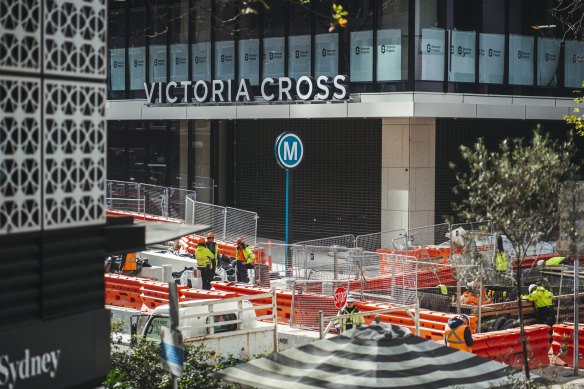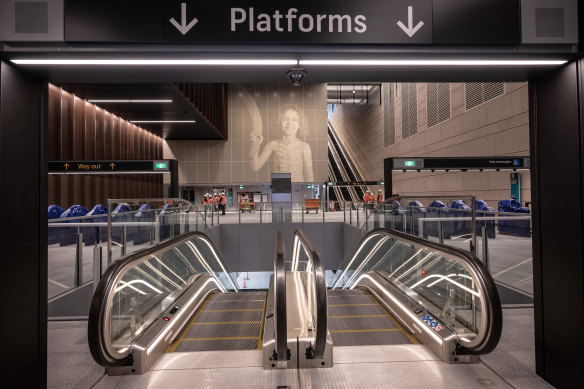- Analysis
- Politics
- NSW
- Sydney Metro
How new metro line links Sydneysiders to the rest of the globe
By Matt Wade
Three dynamic job hubs – the CBD, North Sydney and Macquarie Park – will be better connected by Sydney’s new metro, supercharging the city’s global economic corridor.
The Metro City and Southwest from Chatswood to Sydenham, which has a target opening date of August 4, runs through an urban strip about 25 kilometres long and five kilometres wide that hosts some of Australia’s most productive and globally connected workers. It extends from the Kingsford Smith Airport through the CBD and North Sydney, before arcing north-west to Macquarie Park.
The corridor includes many high-value knowledge-based firms including finance, professional services, information technology, engineering, research and health. It also takes in some of the world’s best universities and is a centre for creative industries, media, marketing and tourism.
KPMG urban economist Terry Rawnsley said the new rail line would allow a higher level of connection between key destinations along the global economic corridor and support the productivity of its firms and workers.
“The new metro will help string together what is already a very big economic entity in a more integrated way,” he said. “The global economic corridor is a magnet for skilled workers and the metro will allow them to get around those areas more easily.”
Economic activity along the corridor is more highly concentrated than the rest of the metropolitan area and other big Australian cities; many of its businesses have proven internationally competitive.

The new Victoria Cross metro station at North Sydney.Credit: Dion Georgopoulos
NSW government estimates show the corridor accounts for more than 41 per cent of the state’s annual economic output.
Macquarie Park, at the north-western end of the corridor, has emerged as one of Australia’s biggest local economies. Modelling by consultancy PWC in 2014 found it was the nation’s seventh-largest locality for economic output (behind the CBDs of Sydney, Melbourne, Perth, Brisbane, Adelaide and North Sydney). Ryde City Council predicts Macquarie Park will become the nation’s “fourth-largest commercial precinct” by 2030.
The business case for the Metro City and Southwest, published by the Baird government in 2016, emphasised how the rail link would “grow and develop” the global economic corridor and contribute to the city’s competitiveness. It labelled the corridor “unique in Australia due to the extent, diversity and concentration of globally competitive industries.”
The business case claimed the project would deliver $1.53 worth of benefits for each $1 invested. However, the project has been plagued by cost overruns: the final $21.6 billion price tag is about $10 billion more than the initial estimate.
The new line will immediately improve access to Sydney’s major employment hubs for workers living in Sydney’s inner south-west. The final stage of the project will extend the metro from Sydenham to Bankstown to allow better connections to workers in south-western Sydney.
Rob Tyson, an economist at advisory firm Polis Partners, said improved access to the Waterloo area made possible by the new metro station would support new growth along Sydney’s inner south corridor.
“I expect Waterloo will become a very different proposition to what it is now with the arrival of the metro, alongside government’s investment in local housing near the station,” he said.
“We’ll see new development, an influx of people, businesses moving in there and a whole new economic mix. It has the potential to stretch the fringe of the CBD down towards that area. So I think that’s going to have a real impact.”

The new Waterloo metro station.Credit: Photo: Wolter Peeters, The Sydney Morning Herald.
The Metro City and Southwest line will extend the Metro Northwest (opened in 2019) to create the new M1 line. This will improve access to the global economic corridor to a large pool of workers in the fast-growing north-western suburbs of Sydney.
In 2022-23 the population of Box Hill-Nelson surged by 27 per cent, while the number of people in the Marsden Park-Shanes Park area jumped by 20 per cent.
North-western Sydney has many tertiary education workers well suited to knowledge-intensive economic activity prevalent along the global economic corridor. The 2021 census showed 37.2 per cent of adults in Baulkham Hills and Hawkesbury statistical district held a bachelor degree level qualification or higher, 11 percentage points above the national average.
Analysis of 2021 census data by consultancy Microburbs found that district also had the highest share of skilled tradespeople and technicians of any Greater Sydney region.
A 2017 NSW government report said that once the new Metro City & Southwest was added to the Metro Northwest line the combined 65-kilometre route would “boost economic activity by more than $5 billion a year”.
State planners have touted important “transport benefits” from the Metro City and Southwest in addition to economic gains. The project’s business case estimated 20,000 private car trips would be transferred to rail by 2036 in the morning peak period due to the project, reducing road congestion. It also claimed the line would reduce traffic and bus congestion across Sydney Harbour and into the CBD.
It will also relieve pressure on Sydney’s rail network, especially congestion on the City Circle Line, and improve “transport network resilience” on the lower north shore and through the CBD.
Start the day with a summary of the day’s most important and interesting stories, analysis and insights. Sign up for our Morning Edition newsletter.